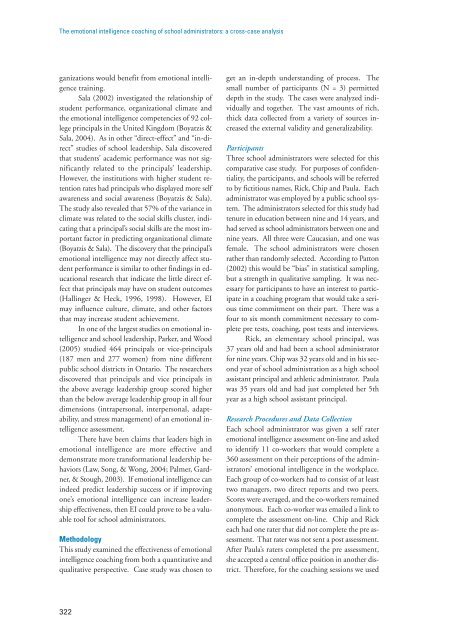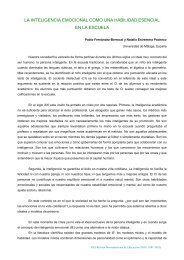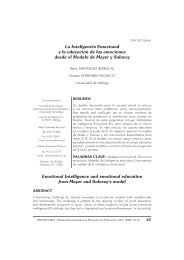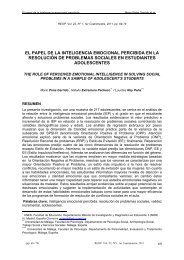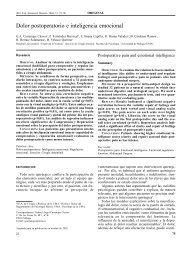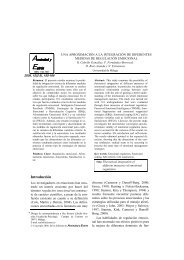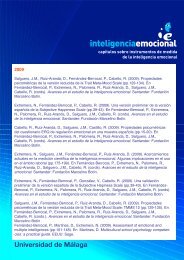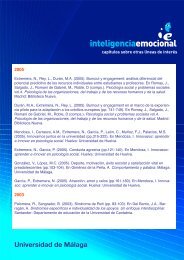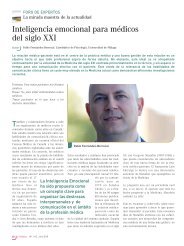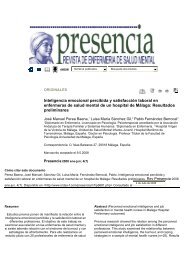Avances en el estudio de la Inteligencia Emocional
Avances en el estudio de la Inteligencia Emocional
Avances en el estudio de la Inteligencia Emocional
Create successful ePaper yourself
Turn your PDF publications into a flip-book with our unique Google optimized e-Paper software.
The emotional int<strong>el</strong>lig<strong>en</strong>ce coaching of school administrators: a cross-case analysis<br />
ganizations would b<strong>en</strong>efit from emotional int<strong>el</strong>lig<strong>en</strong>ce<br />
training.<br />
Sa<strong>la</strong> (2002) investigated the r<strong>el</strong>ationship of<br />
stud<strong>en</strong>t performance, organizational climate and<br />
the emotional int<strong>el</strong>lig<strong>en</strong>ce compet<strong>en</strong>cies of 92 college<br />
principals in the United Kingdom (Boyatzis &<br />
Sa<strong>la</strong>, 2004). As in other “direct-effect” and “in-direct”<br />
studies of school lea<strong>de</strong>rship, Sa<strong>la</strong> discovered<br />
that stud<strong>en</strong>ts’ aca<strong>de</strong>mic performance was not significantly<br />
r<strong>el</strong>ated to the principals’ lea<strong>de</strong>rship.<br />
However, the institutions with higher stud<strong>en</strong>t ret<strong>en</strong>tion<br />
rates had principals who disp<strong>la</strong>yed more s<strong>el</strong>f<br />
awar<strong>en</strong>ess and social awar<strong>en</strong>ess (Boyatzis & Sa<strong>la</strong>).<br />
The study also revealed that 57% of the variance in<br />
climate was r<strong>el</strong>ated to the social skills cluster, indicating<br />
that a principal’s social skills are the most important<br />
factor in predicting organizational climate<br />
(Boyatzis & Sa<strong>la</strong>). The discovery that the principal’s<br />
emotional int<strong>el</strong>lig<strong>en</strong>ce may not directly affect stud<strong>en</strong>t<br />
performance is simi<strong>la</strong>r to other findings in educational<br />
research that indicate the little direct effect<br />
that principals may have on stud<strong>en</strong>t outcomes<br />
(Hallinger & Heck, 1996, 1998). However, EI<br />
may influ<strong>en</strong>ce culture, climate, and other factors<br />
that may increase stud<strong>en</strong>t achievem<strong>en</strong>t.<br />
In one of the <strong>la</strong>rgest studies on emotional int<strong>el</strong>lig<strong>en</strong>ce<br />
and school lea<strong>de</strong>rship, Parker, and Wood<br />
(2005) studied 464 principals or vice-principals<br />
(187 m<strong>en</strong> and 277 wom<strong>en</strong>) from nine differ<strong>en</strong>t<br />
public school districts in Ontario. The researchers<br />
discovered that principals and vice principals in<br />
the above average lea<strong>de</strong>rship group scored higher<br />
than the b<strong>el</strong>ow average lea<strong>de</strong>rship group in all four<br />
dim<strong>en</strong>sions (intrapersonal, interpersonal, adaptability,<br />
and stress managem<strong>en</strong>t) of an emotional int<strong>el</strong>lig<strong>en</strong>ce<br />
assessm<strong>en</strong>t.<br />
There have be<strong>en</strong> c<strong>la</strong>ims that lea<strong>de</strong>rs high in<br />
emotional int<strong>el</strong>lig<strong>en</strong>ce are more effective and<br />
<strong>de</strong>monstrate more transformational lea<strong>de</strong>rship behaviors<br />
(Law, Song, & Wong, 2004; Palmer, Gardner,<br />
& Stough, 2003). If emotional int<strong>el</strong>lig<strong>en</strong>ce can<br />
in<strong>de</strong>ed predict lea<strong>de</strong>rship success or if improving<br />
one’s emotional int<strong>el</strong>lig<strong>en</strong>ce can increase lea<strong>de</strong>rship<br />
effectiv<strong>en</strong>ess, th<strong>en</strong> EI could prove to be a valuable<br />
tool for school administrators.<br />
Methodology<br />
This study examined the effectiv<strong>en</strong>ess of emotional<br />
int<strong>el</strong>lig<strong>en</strong>ce coaching from both a quantitative and<br />
qualitative perspective. Case study was chos<strong>en</strong> to<br />
get an in-<strong>de</strong>pth un<strong>de</strong>rstanding of process. The<br />
small number of participants (N = 3) permitted<br />
<strong>de</strong>pth in the study. The cases were analyzed individually<br />
and together. The vast amounts of rich,<br />
thick data collected from a variety of sources increased<br />
the external validity and g<strong>en</strong>eralizability.<br />
Participants<br />
Three school administrators were s<strong>el</strong>ected for this<br />
comparative case study. For purposes of confid<strong>en</strong>tiality,<br />
the participants, and schools will be referred<br />
to by fictitious names, Rick, Chip and Pau<strong>la</strong>. Each<br />
administrator was employed by a public school system.<br />
The administrators s<strong>el</strong>ected for this study had<br />
t<strong>en</strong>ure in education betwe<strong>en</strong> nine and 14 years, and<br />
had served as school administrators betwe<strong>en</strong> one and<br />
nine years. All three were Caucasian, and one was<br />
female. The school administrators were chos<strong>en</strong><br />
rather than randomly s<strong>el</strong>ected. According to Patton<br />
(2002) this would be “bias” in statistical sampling,<br />
but a str<strong>en</strong>gth in qualitative sampling. It was necessary<br />
for participants to have an interest to participate<br />
in a coaching program that would take a serious<br />
time commitm<strong>en</strong>t on their part. There was a<br />
four to six month commitm<strong>en</strong>t necessary to complete<br />
pre tests, coaching, post tests and interviews.<br />
Rick, an <strong>el</strong>em<strong>en</strong>tary school principal, was<br />
37 years old and had be<strong>en</strong> a school administrator<br />
for nine years. Chip was 32 years old and in his second<br />
year of school administration as a high school<br />
assistant principal and athletic administrator. Pau<strong>la</strong><br />
was 35 years old and had just completed her 5th<br />
year as a high school assistant principal.<br />
Research Procedures and Data Collection<br />
Each school administrator was giv<strong>en</strong> a s<strong>el</strong>f rater<br />
emotional int<strong>el</strong>lig<strong>en</strong>ce assessm<strong>en</strong>t on-line and asked<br />
to id<strong>en</strong>tify 11 co-workers that would complete a<br />
360 assessm<strong>en</strong>t on their perceptions of the administrators’<br />
emotional int<strong>el</strong>lig<strong>en</strong>ce in the workp<strong>la</strong>ce.<br />
Each group of co-workers had to consist of at least<br />
two managers, two direct reports and two peers.<br />
Scores were averaged, and the co-workers remained<br />
anonymous. Each co-worker was emailed a link to<br />
complete the assessm<strong>en</strong>t on-line. Chip and Rick<br />
each had one rater that did not complete the pre assessm<strong>en</strong>t.<br />
That rater was not s<strong>en</strong>t a post assessm<strong>en</strong>t.<br />
After Pau<strong>la</strong>’s raters completed the pre assessm<strong>en</strong>t,<br />
she accepted a c<strong>en</strong>tral office position in another district.<br />
Therefore, for the coaching sessions we used<br />
322


